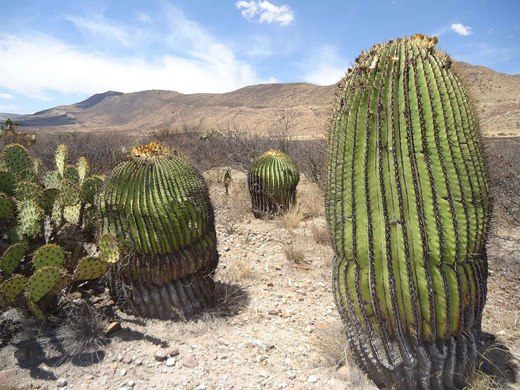Knowledge, Information and Experience
The vegetative forms that many species of cacti take are often of the following three kinds: monstrous, crested and variegated. The monstrous and crested forms are usually mutations; these can either appear as a seedling or as a branch on an otherwise normal plant. A crested plant is one where a head or stem initially fans out, due to which new cells continue to form along a continuous undulating line along the fan. In maturity, most become contorted and quite large.
The American genus Opuntia, represented by four species in India, is now thoroughly naturalised in different types of habitats. Other succulents like Aloe vera, Kalanche pinnata and Sansevieria roxburghiaba were apparently introduced to India in ancient times: reference to these plants exist in Indian mythology and in traditional systems of medicine.
Growth habit:
Cacti show a wide variety of growth habits, which are difficult to divide into clear, simple categories.
Arborescent cacti: They can be tree-like (arborescent), meaning they typically have a single more-or-less woody trunk topped by several to many branches.
Columnar cacti: Smaller cacti may be described as columnar. They consist of erect, cylinder-shaped stems, which may or may not branch, without a very clear division into trunk and branches.
Globular cacti: Cacti whose stems are even smaller may be described as globular (or globose). They consist of shorter, more ball-shaped stems than columnar cacti.
Other forms: Other cacti have a quite different appearance. In tropical regions, some grow as forest climbers and epiphytes.
Stems: The leafless, spiny stem is the characteristic feature of the majority of cacti (and all of those belonging to the largest subfamily, the Cactaceae). The stem is typically succulent, meaning it is adapted to store water.
Leaves: The great majority of cacti have no visible leaves; photosynthesis takes place in the stems (which may be flattened and leaflike in some species). Exceptions occur in three groups of cacti.
Spines: Botanically, “spines” are distinguished from “thorns”: spines are modified leaves, and thorns are modified branches. Cacti produce spines, always from areoles as noted above.
Roots: Most ground-living cacti have only fine roots, which spread out around the base of the plant for varying distances, close to the surface.
Flowers: Like their spines, cactus flowers are variable. Typically, the ovary is surrounded by material derived from stem or receptacle tissue, forming a structure called a pericarpel.
Adaptations for water conservation: All cacti have some adaptations to promote efficient water use. Most cacti—opuntias and cactoids—specialize in surviving in hot and dry environments (i.e. they are xerophytes), but the first ancestors of modern cacti were already adapted to periods of intermittent drought.
Propagated or nursery-raised cacti are more popular in the mass market because they tend to be healthier – free of bug bites, sunburn, and other imperfections. Of all the cacti traded about the world every year, more than 99 percent are propagated, often by large-scale nurseries in the Netherlands, Japan, Brazil and the western us. “In India, the urban needs for cactus is also growing” Says Panda. rprc has been catering to cactus demand in all the major cities of India including the four metros. Beside, the centre has also received export offers from the United Arab Emirates, Holland, Bangladesh and other European countries. “As Indian cities are fast becoming concrete jungles, the cactus plants could provide a green stripe over the buildings,” says Panda. “Of course, it can’t be so helpful in bringing back the natural greenery.”
Tags: Create Life










